Toki Pona: The World’s Simplest Language.
Imagine a language so simple, it can share complex ideas with just 137 words. Toki Pona, made by Canadian linguist Sonja Lang in 2001, is a unique minimalist language. It challenges how we think about talking to each other.
Anúncios
This special language started as a thought experiment to make thoughts and talking simpler. With only about 120-140 words, Toki Pona is a bold way to express ideas. It has drawn in tens of thousands of people who love languages.
Toki Pona is the second most popular constructed language, after Esperanto. It’s especially loved by the young. Its simple design focuses on basic ideas, making it interesting for those who study language and thought.
In 2022, the International Organization for Standardization (ISO) gave Toki Pona its own code, “tok”. This made it an official world language. From a small project to a big experiment, Toki Pona still amazes linguists and learners.
Understanding the Origins of Toki Pona
Sonja Lang created Toki Pona in 2001. It was a deep dive into making language simple during a tough time. She wanted to share thoughts easily and quickly.
Anúncios
- Created during a period of personal depression
- Designed to reduce linguistic complexity
- Published online in August 2001
- Initially claimed to have around 150 words
“Language can be a tool for mental clarity and simplification” – Sonja Lang
Lang’s focus on simplicity led to a new way to talk. It has unique traits:
| Linguistic Feature | Specification |
|---|---|
| Total Words | 120-137 essential words |
| Phonemes | 14 (9 consonants, 5 vowels) |
| Initial Publication | August 8, 2001 |
Soon, Toki Pona caught the eye of many in the language world. By 2007, 10-30 fluent speakers and hundreds more with good skills were found. It showed that simple language can bridge cultures.
Lang turned her personal struggle into a worldwide experiment. She showed that less can mean more in talking to each other.
The Core Principles of Minimalist Communication
Toki Pona is a new way of talking that focuses on the basics. It uses simple words to get to the heart of what we want to say. This makes it different from other languages that use more words.
Toki Pona is all about thinking positively through words. With only 123 words, it makes you think deeply about what you want to say. This simplicity helps people talk clearly and with purpose.
Language is thought made visible. – Toki Pona Philosophy
- Total vocabulary: 123 words
- Learning time: Approximately 30 hours
- Core communication principle: Simplicity
Toki Pona is inspired by Taoist ideas. It teaches us to be present and mindful. By using fewer words, we focus on what really matters in our messages.
| Communication Aspect | Toki Pona Approach |
|---|---|
| Vocabulary Size | 123 words |
| Word Order | Strict Subject-Verb-Object |
| Communication Goal | Simplicity and Clarity |
The language uses just five colors: red, blue, yellow, black, and white. This shows its focus on basic, universal ideas. People learn to say complex things with simple words.
Toki Pona shows that it’s not how many words you use that matters. It’s about saying what you mean in the best way possible. Its simple design makes us think more about our words and their meaning.
Vocabulary and Structure in Toki Pona
Toki Pona is a unique language with just 123 words. It challenges how we talk by using word combinations and understanding the context.

The language uses a few root words to say a lot. People make complex ideas clear by arranging words in creative ways and using context.
“Language is an art of expressing maximum meaning with minimal sounds” – Sonja Lang
Vocabulary Breakdown
- Total unique words: 123
- Verb classifications: 107
- Particles: 5
- Interjections: 3
Word Categories in Toki Pona
| Category | Word Count | Examples |
|---|---|---|
| Color Words | 5 | jelo, laso, loje, pimeja, walo |
| Life Concept Words | 8 | moku, meli, mija, wawa |
| Social Interaction Words | 4 | kulupu, jan, en, pona |
The language focuses on word combinations to share detailed meanings. By arranging root words, speakers can express complex ideas with few words.
Toki Pona shows that you don’t need many words to communicate. Its 123-word vocabulary shows how creativity and context can turn simple words into deep expressions of human experiences.
Phonology and Pronunciation Guide
Toki Pona’s sound system is simple and easy to say. It has only nine consonants and five vowels. This makes it simple for people from different languages to learn.
The way Toki Pona sounds is unique. It has rules that make it easy to use:
- Voiced consonants become voiceless (b > p, d > t, g > k)
- Specific sound conversions like [v] to [w] and [f] to [p]
- Trilled or tapped [r] typically transforms into [l]
- Uvular or velar consonants replace with [k]
Toki Pona’s sound system is simple on purpose. It makes talking clear and easy.
| Phoneme Category | Characteristics | Percentage Distribution |
|---|---|---|
| Vowels | 5 total vowels |
|
| Consonants | 9 total consonants |
Most words in Toki Pona follow a Consonant-Vowel (CV) pattern. This is true for about 75% of words. This makes Toki Pona easy to learn for many people.
“Simplicity is the ultimate sophistication” – A principle embodied by Toki Pona’s phonological design
Learning and Mastering Toki Pona
Exploring Toki Pona is a thrilling adventure in language learning. It breaks away from usual methods. With just 137 words, it’s a simple yet powerful language for those eager to try something new.
Learning Toki Pona is unlike traditional language studies. You can learn the whole language in about 30 hours. This makes it perfect for those who want to learn fast.
- Total vocabulary: 137 words
- Estimated learning time: Around 30 hours
- Complexity: Virtually no traditional grammar
“Toki Pona transforms language learning into a creative, intuitive experience.” – Language Learning Experts
Online communities are key in learning Toki Pona. They offer quick feedback, chances to learn together, and a supportive place for beginners.
| Learning Resource | Type | Accessibility |
|---|---|---|
| Toki Pona Discord | Community Forum | Free |
| Official Language Websites | Educational Platforms | Online |
| Reddit Communities | Discussion Groups | Free |
The language’s unique setup makes you think outside the box. Toki Pona challenges traditional linguistic boundaries. It lets you share complex thoughts with just a few words.
- Context is key in communication
- Phrases can have multiple interpretations
- Emphasizes conceptual understanding
Getting good at Toki Pona is more than just remembering words. It’s about adopting a way of communicating that’s simple yet rich with meaning.
Cultural Impact and Community Growth

The Toki Pona community is a unique group of language lovers. It brings together people from all walks of life. With only 137 words, this simple language has created a special place where everyone can connect.
Looking into the Toki Pona community shows us some interesting facts:
- Nearly 1000 people took part in the Toki Pona census in 2021
- 85% of those who answered could understand the language
- 24% could share complex ideas fully in Toki Pona
- 36% learned it for its deep philosophical meaning
The influence of Toki Pona goes beyond just talking. Toki Pona challenges traditional ways of speaking. It teaches us to simplify complex thoughts into basic ideas.
“Toki Pona is not just a language, it’s a way of thinking about communication itself.” – Language Research Institute
Places like Discord and Reddit play a big role in the Toki Pona community. Memes, songs, and videos show the community’s creativity.
| Community Characteristic | Percentage |
|---|---|
| Respondents Under 20 | 50% |
| North American Members | 50% |
| Weekly Language Users | 50% |
The Toki Pona community’s growth shows how simple communication can unite people. It breaks down barriers of place and culture.
Comparing Toki Pona with Other Constructed Languages
Toki Pona is unique among constructed languages. It takes a minimalist approach to communication. This is different from Esperanto, which aims for international understanding with a complex grammar.
There are key differences between Toki Pona and other languages:
- Vocabulary size: Toki Pona has only 137 words, while Esperanto has many more.
- Grammatical complexity: Toki Pona doesn’t use conjugations or declensions.
- Communication style: It focuses on basic concepts, not detailed technical information.
Toki Pona’s structure is unlike traditional languages. It uses new ways to describe relationships between ideas. For example, “A li x mute; B li x lili” is a formula that simplifies language.
“Language is a tool for understanding, not a barrier to communication.”
Toki Pona’s design is more than just simple. It shows a deeper way of thinking about language. It proves that communication can be clear and meaningful, even with fewer words.
| Feature | Toki Pona | Esperanto |
|---|---|---|
| Total Words | 137 | 2,000+ |
| Alphabet Size | 14 letters | 28 letters |
| Creation Year | 2001 | 1887 |
Toki Pona’s experiment in language is fascinating. It shows that constructed languages can change how we communicate.
Applications and Real-World Usage
Toki Pona is a unique tool with surprising uses in many fields. Language therapy is one of its most interesting applications. It helps people simplify complex emotions with its simple structure.
The language’s simplicity is also great for AI. It makes AI learning easier by cutting down on complex words.
- Therapeutic applications for mental clarity
- Experimental AI language modeling
- Communication skill development
Toki Pona applications go beyond just talking. It’s used as a way to clear your mind. People use it to break down hard thoughts into simpler ones.
“Toki Pona allows us to deconstruct language to its most essential elements” – Language Research Institute
Online platforms have started using Toki Pona too. They create tools and spaces for people to learn and talk together. Its simplicity makes it easy for everyone to learn, breaking down cultural and language barriers.
Conclusion
Toki Pona is a new way of thinking about language. It uses only 120 words and 14 sounds to communicate. This shows that you can say a lot with a little.
The idea behind Toki Pona is not just to make things simple. It makes you think deeply about what you say. It shows that simple can be powerful.
In today’s world, where talking gets more complicated, Toki Pona offers a fresh view. It’s growing in a community that sees its value. It’s not just for fun; it’s a real way to talk.
For those who love languages and talking, Toki Pona is more than a language. It’s a bold try at connecting people. It proves that sometimes, less is more.
